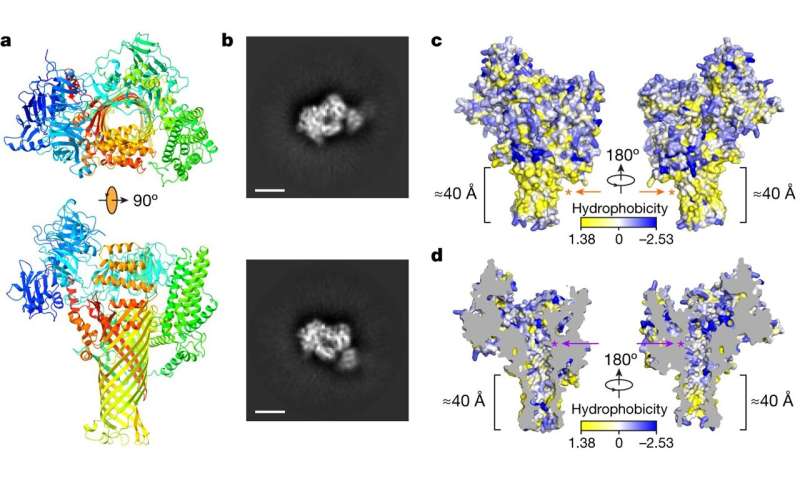How tubular bacterial weapons compromise plant cells to cause disease

Microbes flood leaves and then proliferate in the water-logged patches. New research answers a long-standing question about just how this happens and points toward a potential countermeasure.
Some bacteria attack crops by delivering proteins that puncture the plant's cell membranes, according to new research that explains the long-sought mechanism by which pathogens can release water within plant tissues, causing devastating infections.
In experiments published in Nature, a team led by plant microbiologist Sheng Yang He went a step further and found a way to block the holes the microbes make. Their research identified a plug-like molecule that showed potential for controlling diseases including fire blight, which can kill off apple and pear trees, leaving orchards looking as if they were burned.
"For 25 years, my lab and others have been trying to understand exactly how these bacterial proteins manipulate water within leaves," says He, a Howard Hughes Medical Investigator at Duke University. "Now we have an answer: They open up channels through which water can move, disrupting plants' internal water balance."
Researchers have searched for this kind of detailed insight in hopes of opening the door to improved ways for fighting plant disease. Usually making such a connection can take years, if it is possible at all. However, He and his colleagues capitalized on this discovery quickly—using the dimensions of the pores to identify molecules perfectly sized for blocking them and protecting plants.
A soggy strategy
The battle between pathogen and farmer is as old as agriculture itself, but the stakes have never been higher. Diseases like fire blight can destroy a significant portion of crops meant to feed a growing world population. Meanwhile, climate change is introducing these pathogens into new territories around the world.
In humid conditions, infections caused by a variety of pathogens can first manifest as darkened, water-soaked patches most often on leaves. This flooding shows up between the normally air-filled cell layers where photosynthesis occurs, creating a moist environment where the microbes thrive.
For the new research, the team focused on a group of bacteria that produce closely related proteins for attacking cells. These include DspE, made by Erwinia amylovora, the cause of fire blight. Another, AvrE, is produced by Pseudomonas syringae, the pathogen behind kiwifruit canker, which has caused crop losses around the world, and tomato-damaging bacterial speck. Although scientists have known the identity of these pathogens and their weapons for years, an explanation for specifically how bacteria use them has been a long time coming.
In 2016, He and his colleagues connected some of the dots when they showed that these proteins cause the water-soaked patches. However, the details remained elusive because the proteins are difficult to study and bear little resemblance to more tractable molecules.
That changed when He teamed up with Pei Zhou, a structural biologist also at Duke, and plugged the sequence of amino acids from a handful of these proteins into an artificial intelligence-based tool known as AlphaFold. Based on these sequences, AlphaFold predicted the proteins would form mushroom-shaped tubes, a structure the researchers confirmed by examining them with an imaging technique called cryo-electron microscopy.
He then worked with Ke Dong, a neurophysiologist also at Duke, to better understand what these tube-like proteins do to their target cells. In one set of experiments, they added them to frog eggs, which are often used in such studies. Those eggs with the pores in their membranes swelled, the result of the movement of water and ions through these holes.
In plants, such a shift in the water balance likely takes a different form. Instead of expanding plant cells, it allows the bacteria to extract water from cells and from the vessels that carry it, like blood, throughout the plant's tissues, according to He.
A 'just right' solution
The researchers determined that the passageway within the pore measures about 15 ångstroms in diameter. Knowing this dimension, the researchers went looking for molecules just the right size to block it, landing on spherical, synthetic molecules known as PAMAMs.
The team then tested PAMAMs in plants. When they injected fire blight-causing E. amylovora in pears along with one of these inhibitors, the PAMAM blocked the infection, achieving what Steven Lindow, a plant microbiologist at the University of California, Berkeley, describes as "essentially 100% control of the disease… a very, very dramatic phenomenon."
Currently, growers combat fire blight with several measures, including antibiotics, none of which is fully effective, says Lindow, who was not involved in the research. Preliminary experiments by He's team also suggested the blocker could work against kiwi canker.
The discovery of the pores has implications for many other plant diseases because it uncovers a common means by which bacteria propagate in the spaces between cells in leaves and elsewhere in plants, according to Lindow.
"It's been very difficult to actually kill the bacteria once they're in the plant," he says. "But knowing how they're actually causing disease in this very specific mechanism, I think is going to be an important new target for possible disease control strategies."
More information:
Kinya Nomura et al, Bacterial pathogens deliver water- and solute-permeable channels to plant cells, Nature (2023). DOI: 10.1038/s41586-023-06531-5
Provided by Howard Hughes Medical Institute